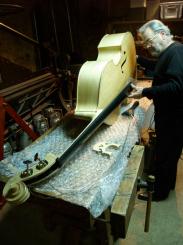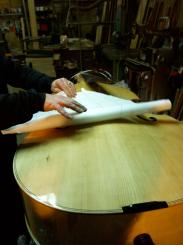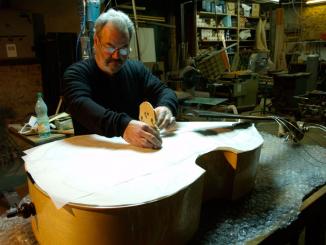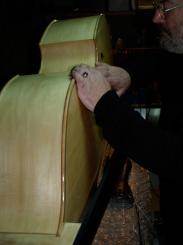Name : Contrebasse (Double bass)
Family : Strings
Date of creation : 2008-2009
Musician : Renaud Garcia-Fons
Our intervention on this instrument mainly concerns the adaptation of the sympathetic resonant strings.
Name : Guitare-VeenaII®
Family : Plucked strings / “Lute” family
Date of creation : 2006
Musician : Georges Alloro
The Guitare-VeenaII® is basically a six stringed electric bass guitar. The frets of the finger board are slightly hollowed so that, when played, its sound is closer to that of a sitar.
Also like the sitar, its strings are set towards the inside of the neck. One can thus apply a traction to the string, changing the height of the note to a fourth.
This instrument has a range of over five octaves for eight melodic strings. The four first strings are played with the frets, the four others are on a smooth finger board.
All the strings have harmonic bridges, magnetic sensors, ceramic and MIDI ones as well.
A rhythmic string is set outside of the neck. It can change tone as the instrument is being played by hooking onto the frets’ edges.
Name : Tampura
Family : “Zither” family
Date of creation : 1985-1986
Created on demand for students specialized in Indian music.
Although it looks very different, this instrument was inspired directly by the Indian instrument of the same name. The Indian Tampura is not a melodic instrument, its role is to give the tone by maintaining, throughout the whole piece of music, the tones and the leading notes of the mode that is played. It is a fretless 4 or 5 stringed instrument which has a special feature: its curved bridge allows the emission of harmonics. It is a typical Indian instrument. However, instruments with a similar function can be found in other musical traditions such as the Occitan “ton-ton”.
The Tampura is an updated version of the traditional instrument, it is lighter, easier to handle and more resistant which allows musicians that have only little experience to make very precise harmonic adjustments.
Name : Zarb plexiglass
Family : Drum placed on a container
Date of creation : 1983
Experimental instrument
Inspired by a Persian instrument, also called Dombak, this Zarb is made of thermoformed polymethylmethacrylate (Plexiglas). It is equipped with a system allowing the adjustment of the skin’s tuning. This instrument is part of research on thermoforming techniques applied to percussion instruments.
Name : Gong à échappement (gong with exhaust pipes)
Family : Sound generator
Date of creation : 1975
Experimental instrument
Stainless steel gong and a sound board supporting a series of sympathetic strings are placed on a triangular frame. The vibration from the gong goes to the strings by passing through and bouncing off the sound board.
This instrument is a completely original design and was made to confirm research of the physical parameters of vibration phases and transmission in the air.
Name : Guitare-Veena®
Family : Plucked strings / “Lute” family
Date of creation : 1966
Musician : Georges Alloro
The Guitar-Veena® was the first instrument ever modified by Georges Alloro. In order to conform to the sound and playing technique of the Veena – one of the main northern Indian classical music instruments – he transformed his own guitar:
- by moving the strings so as to have enough space to apply traction while playing and to change the height,
- by changing the bridge thanks to a bevelled screw allowing the development and enhancing of the harmonics,
- by adding 12 sympathetic resonant strings and a group of 3 rhythmic strings that punctuate the melody.















